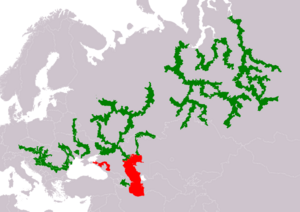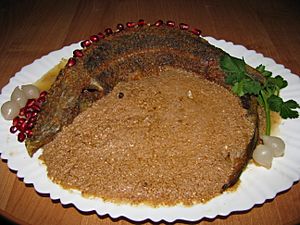Sterlet facts for kids
Quick facts for kids Sterlet |
|
|---|---|
 |
|
| Conservation status | |
| Scientific classification | |
 |
|
| Where the sterlet lives Resident Extinct |
The sterlet (Acipenser ruthenus) is a type of sturgeon fish. It is one of the smaller kinds of sturgeon. You can find them in big rivers across Eurasia. These rivers flow into the Black Sea, Azov Sea, and Caspian Sea. They also live in rivers in Siberia, like the Yenisei.
Sadly, some groups of sterlets that used to travel between fresh and salt water have completely disappeared. These fish are also called sterlet sturgeon.
The number of sterlets has gone down a lot. This is because of too much fishing, pollution, and dams. People fish them for their meat, caviar (fish eggs), and a substance called isinglass. Because of these problems, the sterlet is now considered a vulnerable animal by the IUCN. This means they are at high risk of becoming extinct.
People are trying to help by putting more sterlets back into rivers. Some have been moved to new areas, but they usually don't survive on their own. Today, most sterlets sold around the world come from fish farms, which is called aquaculture.
Contents
What Does a Sterlet Look Like?
- A sterlet can grow up to 100 to 125 centimeters (about 3 to 4 feet) long.
- They can weigh up to 16 kilograms (about 35 pounds).
- Their color can change, but their belly is usually yellowish.
- You can tell them apart from other sturgeons by their many whitish plates on their sides.
- They also have barbels (whisker-like feelers) that are fringed.
- Their snout (nose area) is long and narrow, and its length can vary a lot.
What Do Sterlets Eat?
Sterlets mostly eat small creatures that live at the bottom of rivers. They commonly feed on tiny crustaceans, worms, and insect larvae (young insects).
Sterlet Life Cycle and Reproduction
Sterlets can live for a long time, usually up to 22 to 25 years.
- Male sterlets are ready to have babies when they are 3 to 7 years old.
- Female sterlets are ready when they are 4 to 12 years old.
- They lay their eggs from mid-April to early June.
- A female can lay between 15,000 and 44,000 eggs.
- They prefer water temperatures between 12 and 17 degrees Celsius (54–63 degrees Fahrenheit) for laying eggs.
Sterlets as Pond Fish
If you want to keep sterlets in a pond, you need a big pond. The water conditions must be very good. Sterlets can sometimes get tangled in plants like blanketweed. They also need special food, like sterlet sticks. This is because they can't digest the plant proteins found in regular fish food.
Sterlets as Food

In Russia, people really value the sterlet. Its meat is considered excellent. It also helps make some of the best kinds of caviar and isinglass.
Sterlets in the Danube River
The sterlet is the last of five types of sturgeon that used to live in the Middle and Upper Danube River. Their numbers have dropped a lot in this river. This is mainly because their homes, places to lay eggs, and feeding areas have been damaged.




